Abstract
There is a persistent shortage of allografts available for transplantation, so we envisioned using non-heart beating donation to expand the donor pool. Non-heart beating donors (NHBD) were categorized using four definitions. Controlled donors, consisting of categories III and IV, are the most suitable for NHBD. Delayed graft function is associated with the use of kidneys from such donors, but had no difference on graft survival in the long-term results compared with heart beating donors. The proportion of NHBD of deceased donors differs considerably among countries, but national programs in many nations have now been initiated to increase the rate of non-heart beating donation. In most cases, the organs from NHBD are not available for transplantation in Korea because of legal restrictions. The use of controlled NHBD is encouraged to expand available allografts in Korea, due to the shortage of such allografts
Go to : 
References
1). Kootstra G, van Heurn E. Non-heartbeating donation of kidneys for transplantation. Nat Clin Pract Nephrol. 2007; 3:154–63.

2). A definition of irreversible coma. Report of the Ad Hoc Committee of the Harvard Medical School to Examine the Definition of Brain Death. JAMA. 1968; 205:337–40.
3). Brasile L, Stubenitsky B, Booster M, Kootstra G. The cadaveric kidney and the organ shortage-a perspective review. Clin Transplant. 2001; 15:369–74.
4). Brook NR, White SA, Waller JR, Veitch PS, Nicholson ML. Non-heart beating donor kidneys with delayed graft function have superior graft survival compared with conventional heart-beating donor kidneys that develop delayed graft function. Am J Transplant. 2003; 3:614–8.

5). Kootstra G, Daemen JH, Oomen AP. Categories of non-heart-beating donors. Transplant Proc. 1995; 27:2893–4.
6). Reich DJ, Mulligan DC, Abt PL, Pruett TL, Abecassis MM, D'Alessandro A, et al. ASTS recommended practice guidelines for controlled donation after cardiac death organ procurement and transplantation. Am J Transplant. 2009; 9:2004–11.

7). Hoogland ER, Snoeijs MG, van Heurn LW. DCD kidney transplantation: results and measures to improve outcome. Curr Opin Organ Transplant. 2010; 15:177–82.

8). Moers C, Leuvenink HG, Ploeg RJ. Non-heart beating organ donation: overview and future perspectives. Transpl Int. 2007; 20:567–75.

9). Kim YH. Renal transplantation from non-heart beating donors: a promising alternative to enlarge the donor pool. J Korean Soc Transplant. 2007; 21:4–8. (김영훈. 심정지 공여자로부터의 신장이식: 공여자 부족에 대한 새로운 해결책. 대한이식학회지 2007;21: 4–8.).
10). The U.S. Organ Procurement and Transplantation Network and the Scientific Registry of Transplant Recipients (OPTN/SRTR). Annual Report [Internet]. Washington, D.C. USA: the Department of Health and Human Services;. 2008. [cited 2010 Aug 31]. Available from:. http://optn.transplant.hrsa.gov/data/annualReport.asp.
11). van Gelder F, Manyalich M, Nanni Costa Alessandro, Paez Gloria. 2009 international donation and transplantation activity. IRODaT preliminary data. Organs Tissue Cells. 2010; 13:5–8.
12). Gok MA, Asher JF, Shenton BK, Rix D, Soomro NA, Jaques BC, et al. Graft function after kidney transplantation from non-heartbeating donors according to maastricht category. J Urol. 2004; 172:2331–4.

13). Keizer KM, de Fijter JW, Haase-Kromwijk BJ, Weimar W. Non-heart-beating donor kidneys in the Netherlands: allocation and outcome of transplantation. Transplantation. 2005; 79:1195–9.

14). Sánchez-Fructuoso A, Prats Sánchez D, Marqués Vidas M, López De Novales E, Barrientos Guzmán A. Non-heart beating donors. Nephrol Dial Transplant. 2004; 19(Suppl 3):iii26–31.
15). Hattori R, Ono Y, Yoshimura N, Hoshinaga K, Nishioka T, Ishibashi M, et al. Long-term outcome of kidney transplant using non-heart-beating donor: multicenter analysis of factors affecting graft survival. Clin Transplant. 2003; 17:518–21.

16). Cho YW, Terasaki PI, Cecka JM, Gjertson DW. Transplantation of kidneys from donors whose hearts have stopped beating. N Engl J Med. 1998; 338:221–5.

17). Koffman G, Gambaro G. Renal transplantation from non-heart-beating donors: a review of the European experience. J Nephrol. 2003; 16:334–41.
18). Thomas I, Caborn S, Manara AR. Experiences in the development of non-heart beating organ donation scheme in a regional neurosciences intensive care unit. Br J Anaesth. 2008; 100:820–6.
19). Barlow AD, Metcalfe MS, Johari Y, Elwell R, Veitch PS, Nicholson ML. Case-matched comparison of longterm results of non-heart beating and heart-beating donor renal transplants. Br J Surg. 2009; 96:685–91.

20). Locke JE, Segev DL, Warren DS, Dominici F, Simpkins CE, Montgomery RA. Outcomes of kidneys from donors after cardiac death: implications for allocation and preservation. Am J Transplant. 2007; 7:1797–807.

21). Akoh JA, Denton MD, Bradshaw SB, Rana TA, Walker MB. Early results of a controlled non-heart-beating kidney donor programme. Nephrol Dial Transplant. 2009; 24:1992–6.

22). Chapman J, Bock A, Dussol B, Fritsche L, Kliem V, Lebranchu Y, et al. Follow-up after renal transplantation with organs from donors after cardiac death. Transpl Int. 2006; 19:715–9.

23). Korean Network for Organ Sharing (KONOS). Annual Data Report [Internet]. Seoul: KONOS;2010. [cited 2010 Aug 31]. Available from:. http://www.konos.go.kr/jsp/front/m05/sub_01.jsp.
24). Wijnen RM, Booster MH, Stubenitsky BM, de Boer J, Heineman E, Kootstra G. Outcome of transplantation of non-heart-beating donor kidneys. Lancet. 1995; 345:1067–70.

25). Metcalfe MS, Butterworth PC, White SA, Saunders RN, Murphy GJ, Taub N, et al. A case-control comparison of the results of renal transplantation from heart-beating and non-heart-beating donors. Transplantation. 2001; 71:1556–9.

26). Weber M, Dindo D, Demartines N, Ambuhl PM, Clavien PA. Kidney transplantation from donors without a heartbeat. N Engl J Med. 2002; 347:248–55.

27). Gok MA, Buckley PE, Shenton BK, Balupuri S, El-Sheikh MA, Robertson H, et al. Long-term renal function in kidneys from non-heart-beating donors: a singlecenter experience. Transplantation. 2002; 74:664–9.
28). Sudhindran S, Pettigrew GJ, Drain A, Shrotri M, Watson CJ, Jamieson NV, et al. Outcome of transplantation using kidneys from controlled (Maastricht category 3) non-heart-beating donors. Clin Transplant. 2003; 17:93–100.

Go to : 
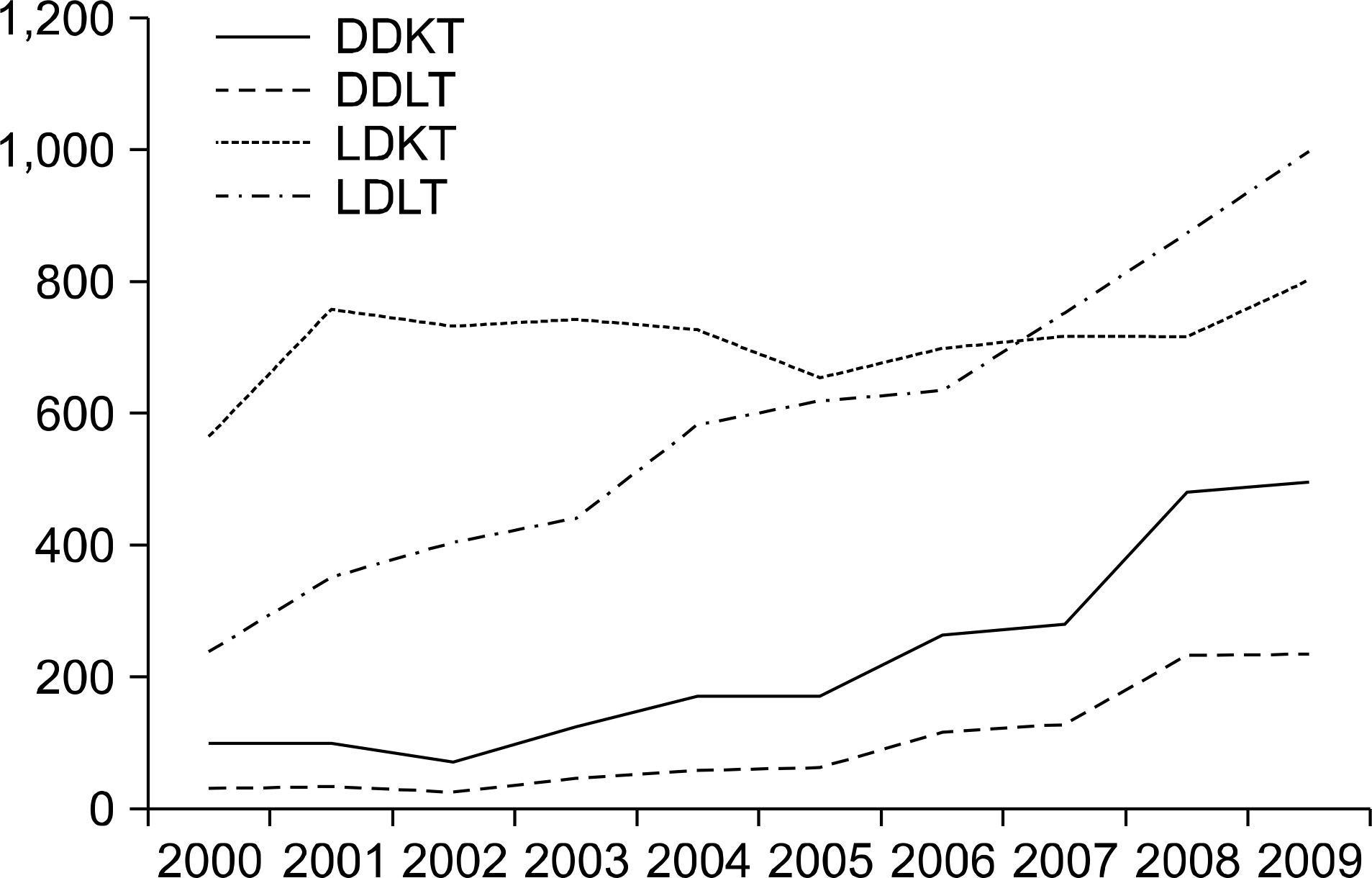 | Fig. 1.The number of kidney and liver transplantation in Korea. Abbreviations: DDKT, deceased donor kidney transplantation; DDLT, deceased donor liver transplantation; LDKT, living donor kidney transplantation; LDLT, living donor liver transplantation. Adapted from reference [23]. |
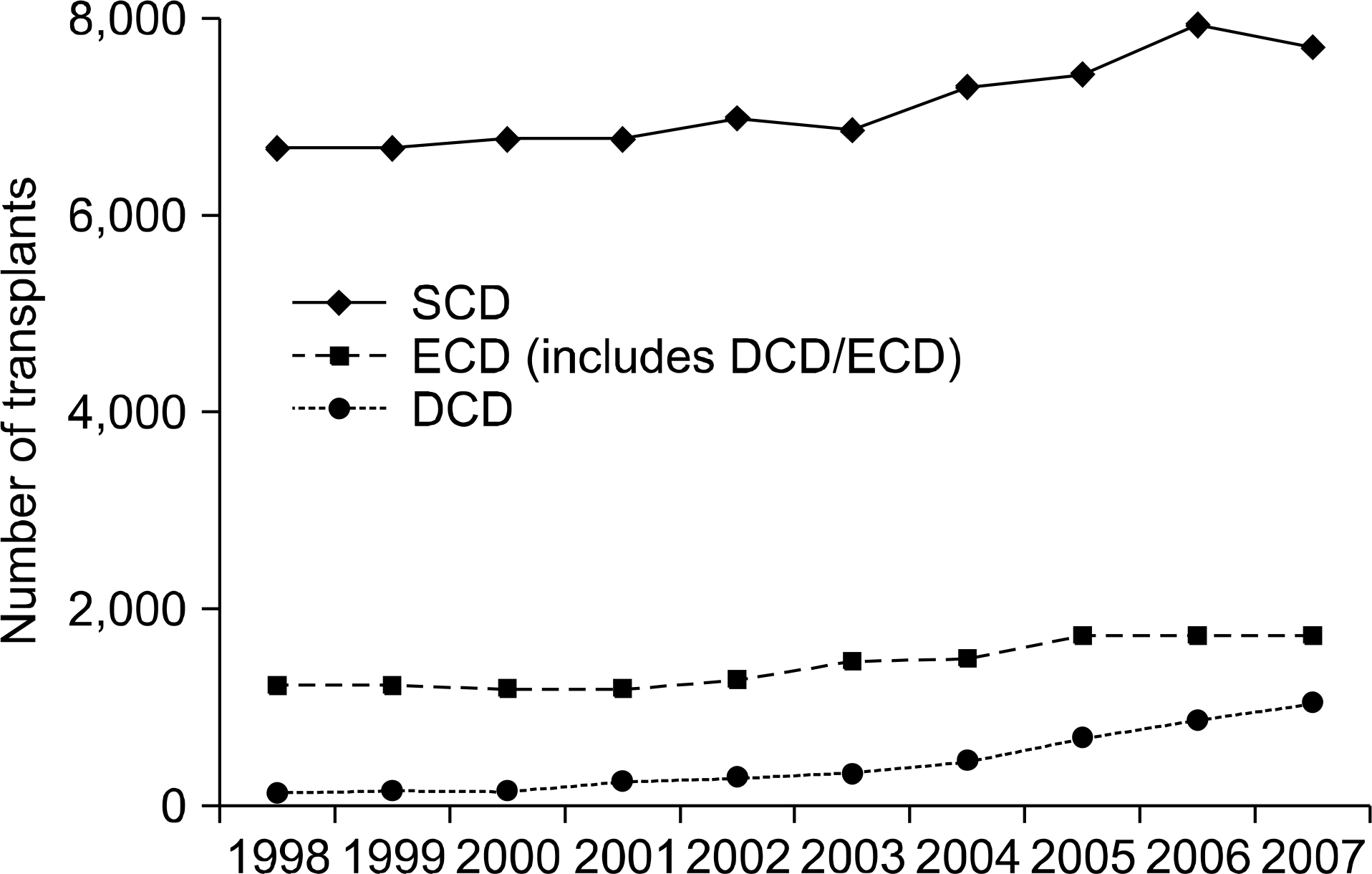 | Fig. 2.Transplant numbers by donation type. Abbreviations: SCD, standard criteria donor; ECD, extended criteria donor; DCD, deceased cardiac death donor. Reprinted from Fig. III-3 of reference [10]. |
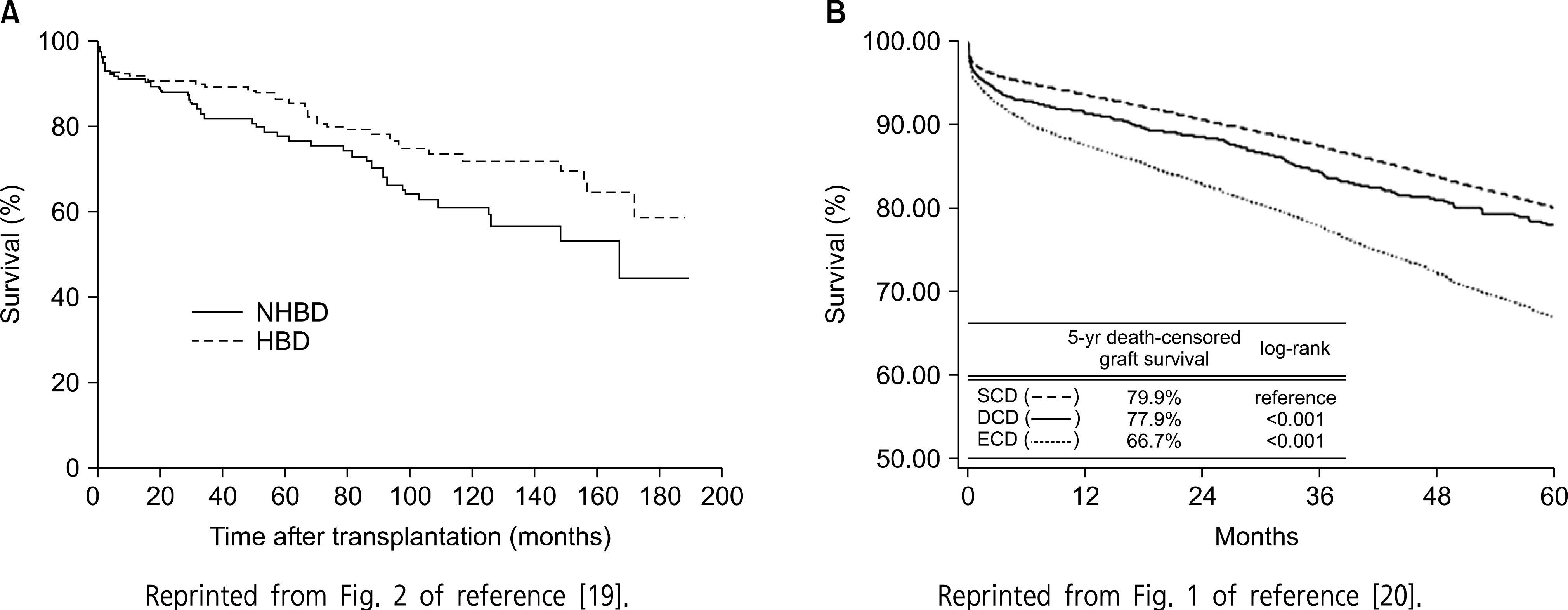 | Fig. 3.(A) Long-term outcome for deceased donor by donor type, (B) The graft survival rate by donor type. Abbreviations: NHBD, non-heart beating donor; HBD, heart beating donor; SCD, standard criteria donor; ECD, extended criteria donor; DCD, deceased cardiac death donor. |
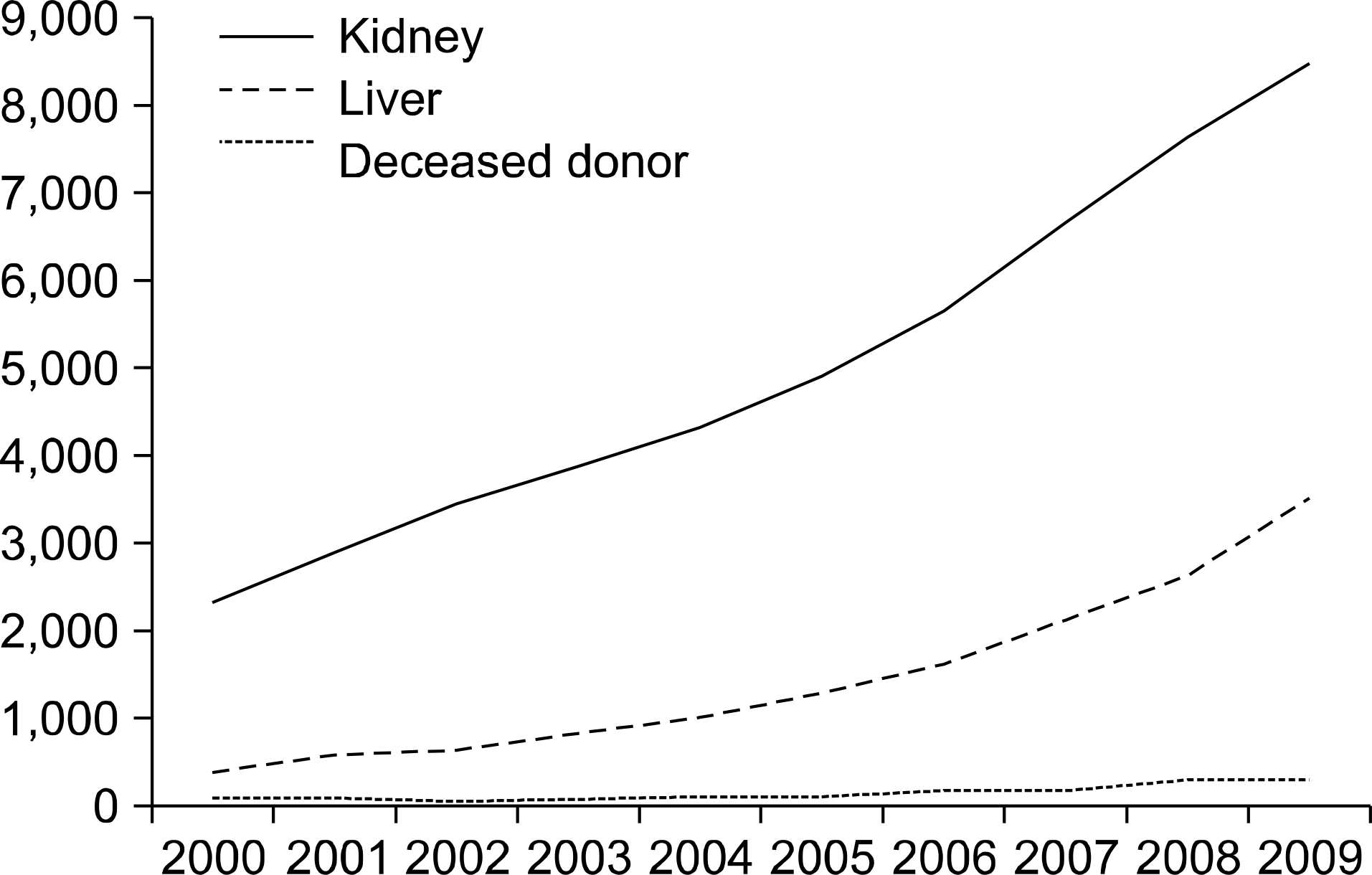 | Fig. 4.Waiting lists and the number of deceased donor in Korea. Adapted from reference [23]. |
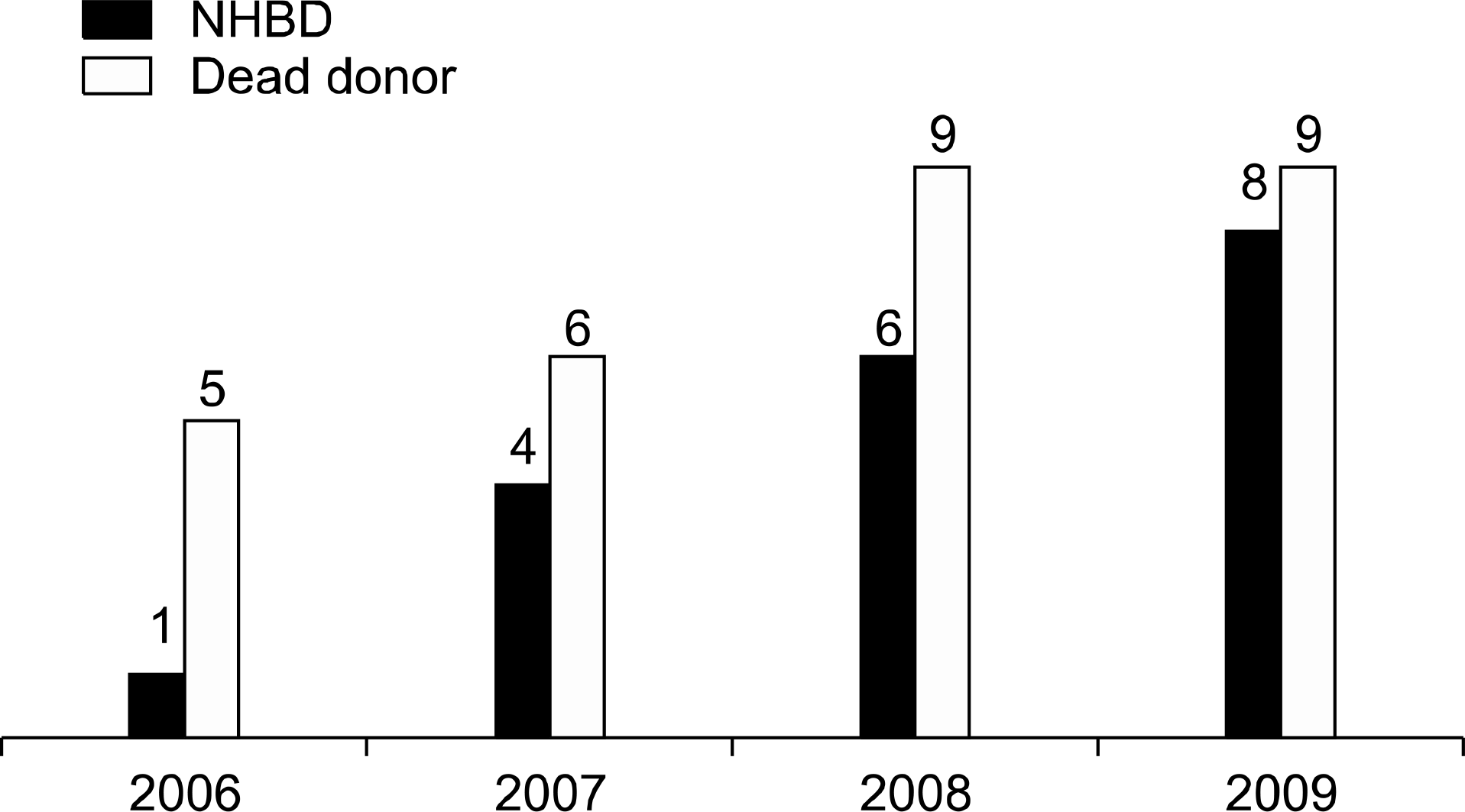 | Fig. 5.The number of non-heart beating donation (NHBD) and dead donor for evaluating brain death between 2006 and 2009. |
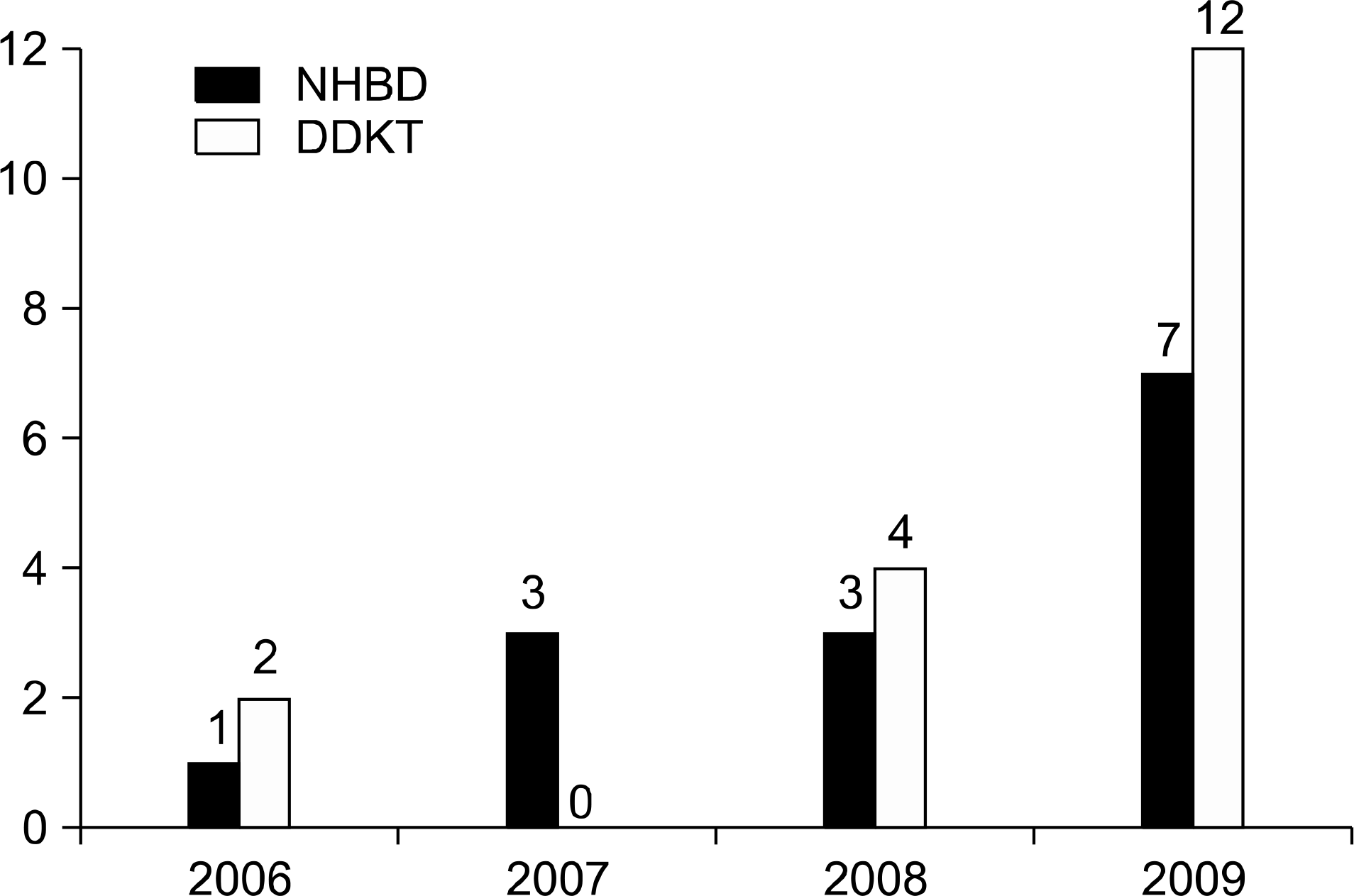 | Fig. 6.Non-heart beating donation (NHBD) at Samsung Medical Center. Abbreviation: DDKT, deceased donor kidney transplantation. |
 | Fig. 7.Serum creatinine levels by donor type at Samsung Medical Center (means, 95% confidence intervals) (P<0.05). Abbreviations: SCD, standard criteria don; ECD, extended criteria donor; NHBD, non-heart beating donor. |
Table 1.
Maastricht classification of non-heart beating donor
| Category | Description | Procurement |
| I | Dead on arrival | Uncontrolled |
| II | Unsuccessful resuscitation | Uncontrolled |
| III | Awaiting cardiac arrest | Controlled |
| IV | Cardiac arrest while brain dead | Controlled |
Table 2.
International organ donation and transplantation
Table 3.
Studies on non-heart beating donation and heart beating donation




 PDF
PDF ePub
ePub Citation
Citation Print
Print


 XML Download
XML Download